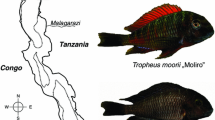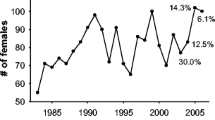Abstract
We studied pairing success in male rock ptarmigan (Lagopus mutus) in northern Alaska to learn whether males obtaining more females possessed phenotypic traits that influenced female choice directly, whether these traits permitted males to obtain territories favored by females, or whether both processes occurred. The number of females per male varied from zero to three. Several male and territory traits were significantly correlated with number of females per male. We used multiple regression to obtain a single measure of male quality and a single measure of territory quality. These measures of male and territory quality correlated with each other and with male pairing success. We used path analysis to separate direct effects of male quality on pairing success from indirect effects due to high-quality males obtaining high-quality territories. Both direct and indirect pathways had significant effects on pairing success, and direct and indirect effects of male traits on pairing success were about equal. This study illustrates an analytical approach for estimating the relative importance of direct and indirect causal relationships in natural systems.
Similar content being viewed by others
Author information
Authors and Affiliations
Additional information
Received: 13 January 1998 / Accepted after revision: 7 November 1998
Rights and permissions
About this article
Cite this article
Bart, J., Earnst, S. Relative importance of male and territory quality in pairing success of male rock ptarmigan (Lagopus mutus). Behav Ecol Sociobiol 45, 355–359 (1999). https://doi.org/10.1007/s002650050571
Issue Date:
DOI: https://doi.org/10.1007/s002650050571




